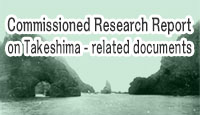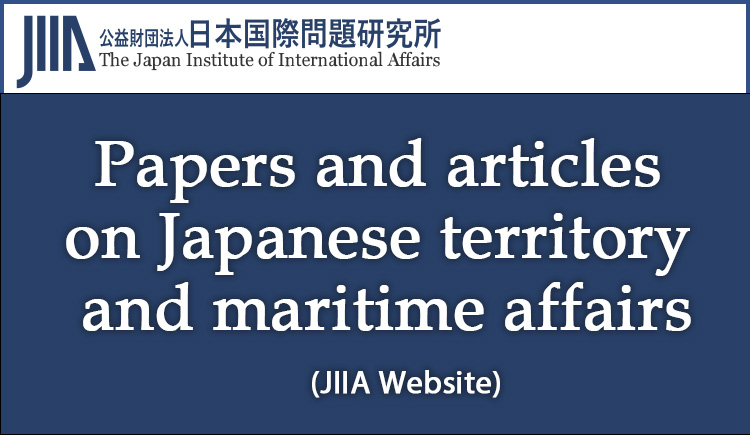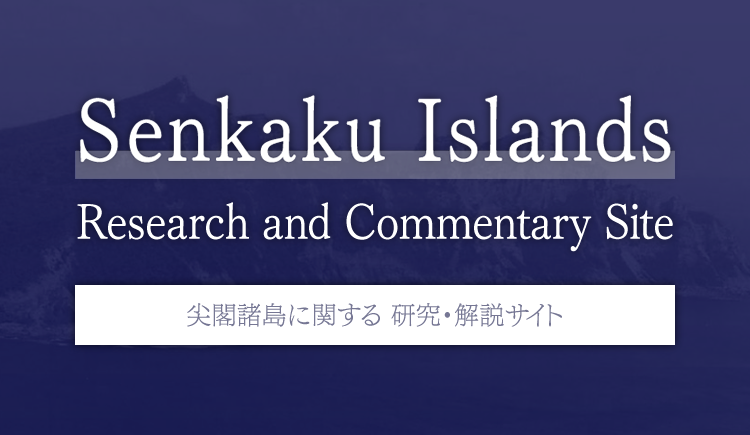The documents and materials published on this website were collected, researched, and prepared with advice from experts, as a part of a Government-commissioned project. The contents of this website do not reflect the views of the Government. Links to external sites (domains other than https://www.cas.go.jp) are not under the management of this site. For linked websites, please check with the organization/group that manages the website for the link in question.
Analysis of claims by other countries
Column On “Usan Island” in old Korean documents
TSUKAMOTO Takashi (Former Professor, Tokai University)
*Adobe Acrobat Reader DC, provided by Adobe, is needed to view the PDF files. If you do not have the software, please download it from the linked site. Adobe Acrobat Reader DC
1. Summary
An old Korean book, Sejong Sillok Jiriji (Geography Section of the Annals of King Sejong’s Reign, 1454), states, “Usan, Mureung, two islands, are in the sea due east of the [Uljin] prefecture. The two islands are not far apart and are visible on a clear day. They were called Usan State in the Silla period.”1 The Government of the Republic of Korea (“ROK”) connects this with Takeshima (Korean name: “Dokdo”) and claims that “in Sejong Sillok Jiriji, it is recorded that Ulleungdo (Mureung) and Dokdo (Usan) are two islands that are part of Joseon’s Uljin prefecture; it is also recorded that the two islands had been territories of Usan State, which was subjugated to Silla in the early 6th century, indicating that Korea’s effective control over Dokdo dates back to the Silla period.” However, the entire article of Sejong Sillok Jiriji is pertaining to Ulleungdo. It is most probable that there was an Usan State on Ulleungdo in the 6th century, and as time passed, it came to be believed that there is an Usan Island separate from Ulleungdo. Usan in Sejong Sillok Jiriji is either an imaginary island or Ulleungdo. It is not Takeshima.
Note 1
Sejong Sillok Jiriji『世宗實錄』地理志 江原道蔚珍縣条, 國史編纂委員會『朝鮮王朝實錄 五』Seoul: 東國文化社, 1956, p. 680.
2. The ROK’s view that “Usan” in old Korean documents is Takeshima
The ROK’s claim is as follows: <Quotation from MOFA-ROK’s pamphlet2>
P. 5
2 Geographical Recognition of Dokdo and Relevant Historical Evidence
A. Dokdo has been recognized geographically as a part of Ulleungdo.
On a clear day, Dokdo is visible to the naked eye from Ulleungdo (Ulleung Island), the island which lies in closest proximity (87.4 km) to Dokdo. Given its geographical location, Dokdo has historically been considered to be a part of Ulleungdo.
This is well evidenced in early Korean documents. For instance, the Joseon (Korean) government publication
While there are numerous adjacent islands surrounding Ulleungdo, Dokdo is the only one visible to the naked eye from Ulleungdo on a clear day.
P. 6
B. Korean government publications record that Korea has long recognized Dokdo as Korean territory and exercised effective control over the island.
In the Joseon (Korean) government publication
Consistent records pertaining to Dokdo are also found in other governmental publications, including
Particularly noteworthy is the record in the volume “Yeojigo” in
Note 2
MOFA (ROK), Dokdo, Beautiful Island of Korea - Pamphlet, pp. 5-6. (access: May 17, 2023.)
3. Sejong Sillok Jiriji and its article on Ulleungdo
Sejong Sillok Jiriji is a geography book of eight provinces of Korea contained in Sejong Sillok (Annals of King Sejong’s Reign) (1454). King Sejong is the fourth king (1418-1450) of the Rhee family (Joseon Dynasty). Soon after his accession to the throne, the King ordered each Province to compile and submit a record of its geography.3 Gyeongsang-do Jiriji (Geography of Gyeongsang Province, 1425) (the only surviving Provincial geography) is an example. Then Sinchan Paldo Jiriji (Newly Edited Geography of Eight Provinces) was compiled in 1432, which became the basis of Sejong Sillok Jiriji.4 The article on “Usan, Mureung” in Sejong Sillok Jiriji is as follows: <For the original text, see Document 1.>
Usan, Mureung, two islands, are located in the sea due east of the [Uljin] prefecture. The two islands are not far apart, and they can be seen if the weather is clear. [They were c]alled Usan State in the Silla period. Another name is Ulleungdo. The land is a hundred ri [unit] square. Usan State had not submitted itself to Silla, relying on the steepness of the land. In the twelfth year of King Jijeung, Isabu became military commander of Haseulla province, and said, “The Usan people are intrepid. It is difficult to make them obey by force. We should rather make them give in by trickery.” He made many wooden beasts of prey, placed them on battle ships, sailed to the country, and deceivingly said that he would let the beasts go. The people of Usan State surrendered in fear. In the thirteenth year of Goryeo Taejo [the first King of Goryeo Kingdom], islanders Baekgil and Todu presented products [to the King]. In the thirteenth year of King Uijong, inspector Kim Yu-Rib and others returned and reported: “There is a big mountain on the island. From the top of the mountain to the sea it is 10,000 odd bo [unit of distance] eastwards, 13,000 odd bo westwards, 15,000 odd bo southwards, and 8,000 odd bo northwards. There are vestiges of village in seven places and are such relics as stone Buddhist images, iron bells and stone towers. Many Jaeho, hobon and seoknam-cho [medicinal plants] grow there. During the reign of Taejo of the present dynasty, the King, having heard that many people took refuge on the island, appointed Kim Rin-U of Samcheok as “Appeasing Officer” again, evacuated the inhabitants and made the island uninhabited. Rin-U said, “The land is fertile, a bamboo is big as a column, a rat is big as a cat, a peach is bigger than a measuring cup; this is how things are there.”
Note 3
TAGAWA Kozo田川孝三「竹島領有に関する歴史的考察」『東洋文庫書報』20 (1988) p. 43.
Note 4
Ibid., p. 44.
Document 1
Sejong Sillok Jiriji『世宗實録』地理志 “Gang-weon province, Uljin prefecture” 江原道蔚珍縣条
view image >>
<Transcription>
于山武陵二島在縣正東海中 [分注]二島相去不遠 風日清明則可望見 新羅時稱于山國 一云欝陵島 地方百里 恃險不服 智證王十二年 異斯夫爲何瑟羅州軍主 謂于山人愚悍 難以威來 可以計服 乃多以木造猛獸 分載戰船 抵其國 誑之曰 汝若不服則即放此獸 國人懼來降 高麗太祖十三年 其島人使白吉土豆 獻方物 毅宗十三年 審察使金柔立等 回來告 島中有泰山 從山頂向東行至海一萬餘歩 向西行一萬三千餘歩 向南行一萬五千餘歩 向北行八千餘歩 有村落基址七所 或有石佛像鐵鐘石塔 多生柴胡蒿本石南草 我 太祖[宗]時 聞流民迯入其島者甚多 再命三陟人金麟雨 爲安撫使 刷出空其地 麟雨言 土地沃饒 竹大如柱 鼠大如猫 桃核大於升 凡物稱是
4. Interpretation that Takeshima is visible from Ulleungdo
The validity of the ROK’s claims based on Sejong Sillok Jiriji is hereinafter examined.
First, the assertion that Sejong Sillok Jiriji states, “Usan [Dokdo], Mureung [Ulleungdo] … The two islands are not far apart from each other and thus visible on a clear day” (section 2, underlined part (1) above) is a quotation from an article of Sejong Sillok Jiriji which states “Usan, Mureung, two islands, are located in the sea due east of the [Uljin] prefecture. The two islands are not far apart, and they can be seen if the weather is clear.” However, the “Dokdo” in square brackets (“Usan [Dokdo]”) is an interpretation made and inserted by the ROK, and was not in the original. A report from 1906 by Uldo county magistrate Sim Heung-Taek is the first Korean document in which the name Dokdo appears. Why, then, does the ROK interpret Usan to be Takeshima? The MOFA pamphlet explains that “while there are numerous adjacent islands surrounding Ulleungdo, Dokdo is the only one visible to the naked eye from Ulleungdo on a clear day.” That is, assuming one has the modern knowledge that Ulleungdo and Takeshima are in the sea to the east of the Korean Peninsula, since Sejong Sillok Jiriji states that there are two islands of Usan and Mureung and since Mureung is Ulleungdo, accordingly Usan must be Takeshima; although there are many islets around Ulleungdo, Takeshima is the only one which is visible from Ulleungdo on a clear day. (Other islets are located so near that they are visible from Ulleungdo on a daily basis.)
Takeshima
Research and Commentary Site
- I Comprehensive issues
- II Commentary on themes by historical period
- III Analysis of claims by other countries





